Roman Treasure
Roman Treasure!
A hoard of 22 silver coins found near Mansfield Woodhouse
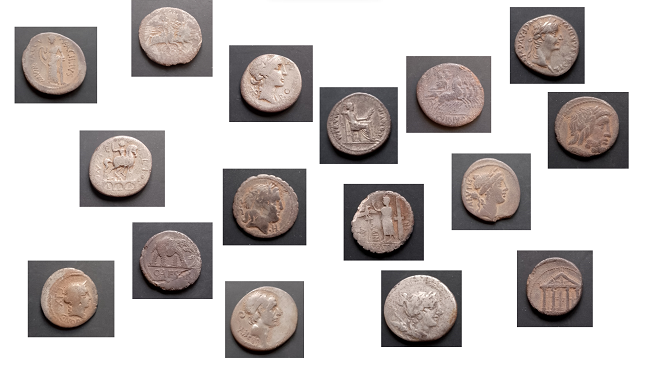
In 2007 explorers using metal detectors made an exciting find near Mansfield Woodhouse – 22 silver coins from the Roman period. The coins were clearly a ‘hoard’ - all buried together at the same time, around the middle of the 1st century CE. The finders reported their discovery to the coroner, and they were declared as treasure, under the Treasure Act 1996. They were researched by the British Museum, then valued by the Treasure Valuation Committee, and in 2009 Mansfield Museum was able to purchase them.
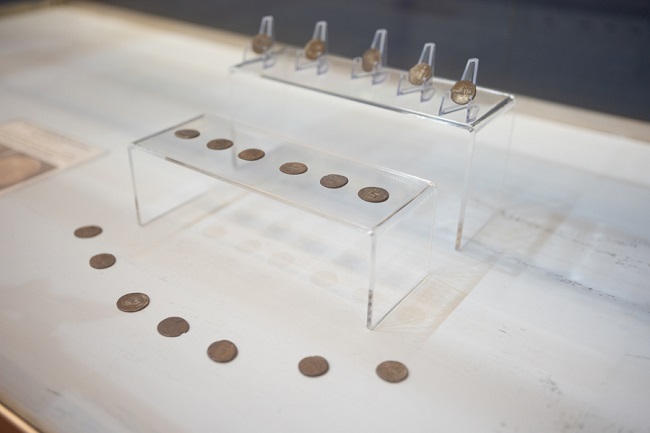
We know that the area of Mansfield Woodhouse was occupied in the Roman period. Archaeological digs have found evidence of a settlement with Roman-style wooden buildings made around 80 CE. This was replaced with a stone villa complex about 100 years later. We don’t know who buried the hoard of coins, or whether they were actually living here, but Roman influence was clearly strong in this area.
The coins are all ‘denarii’ – the silver coin which was the mainstay of early Roman money. The value of a denarius varied over the centuries, but in the 1st century CE it was worth about the same as a £50 note is today. This hoard of 22 coins would therefore be able to buy about as much as £1100 would today.
One interesting feature is that the coins were already old when they were buried. 19 of them were made under the Roman Republic – before it became an empire. The oldest coin can be dated to 179 – 170 BCE. The three most recent coins are from the reign of Emperor Tiberius (14 – 37 CE). The coins were therefore made over a period of at least 184 years. On top of this, Britain didn’t become part of the Roman Empire until after Emperor Claudius’ invasion, from 43 CE onwards. By the time the coins were buried near Mansfield Woodhouse, the oldest coin had been in circulation for around 220 years.
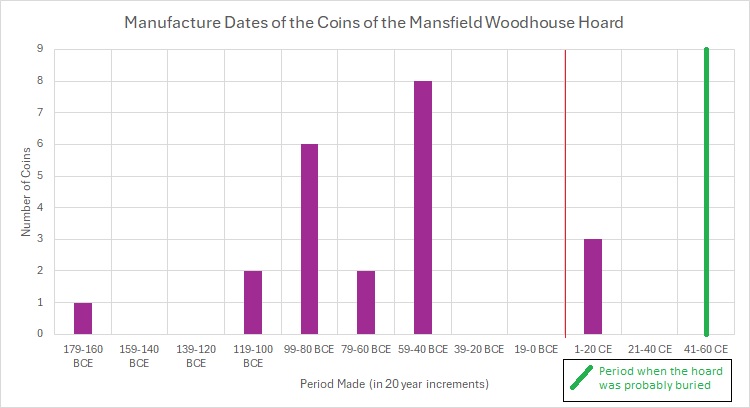
Looking at other British hoards buried at about the same time, it seems this was quite common: people continued using old coins for decades (or centuries!) after they were made.
Coins of the Roman Republic and coins of the first Emperors continued to circulate throughout the 1st century. This was partly because the coins are of good quality metal with a very high silver content (generally around 93% pure)., but there was also very little silver mined in the 25 years after Tiberius’ reign so older coins stayed in circulation because there weren’t many new ones.
The Coins
Coins of the Roman Republic usually had a portrait of a god or goddess on the front. The back often showed another deity, or celebrated a victory or a feat of architecture or engineering. In the later period, they also had the name of the mint official who was in charge when they were made. These coins sometimes showed important ancestors of the mint official, to prove their good family standing. Coins of the Empire almost always had a portrait of the Emperor on the front, and a religious or commemorative image on the back.
Here are the details of the 22 coins:
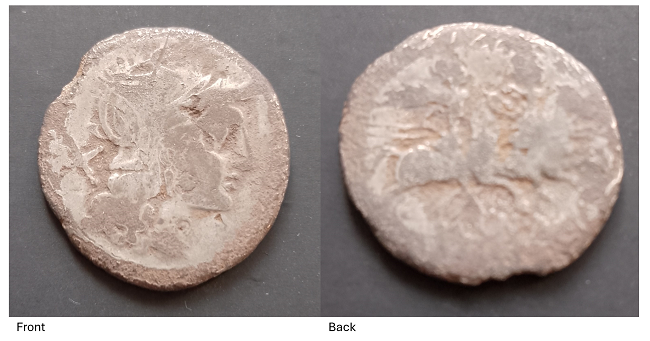
1. This is the oldest coin in the hoard: a denarius of the Roman Republic, dating to 179-170 BCE.
The front has the head of Roma (the personification of Rome), wearing a helmet and facing right. The letter X appears behind her head.
The back has two gods on horseback, racing to the right. These are the 'Dioscuri' – Castor and Pollux, the twin sons of Leda and Zeus who were believed to be able to affect winds at sea, and to help shipwrecked sailors. The word 'ROMA' is inscribed beneath the Dioscuri.
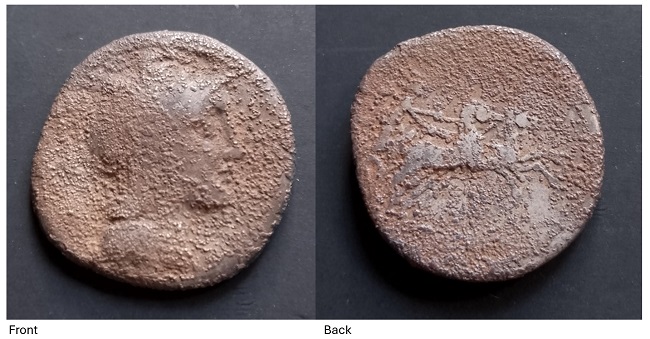
2. A denarius of the Roman Republic, dating to 110-109 BCE.
The front has the head of Roma (the personification of Rome), wearing a helmet and facing right.
The back has the figure of Victory, in a two-horse chariot, heading right. She is holding the reins in both hands.
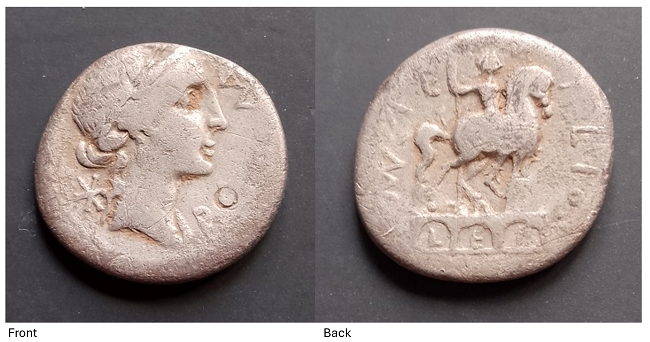
3. A denarius of the Roman Republic, dating to 114-113 BCE.
The front has a female head, which is probably Roma, wearing a laurel wreath and diadem, and facing right. It reads "ROMA" in front of the face and has a star behind.
The back shows a statue of a man on horseback, wearing body armour and a laurel wreath, and holding a spear. The statue is on a plinth with three arches. The inscription on the back reads "MN AEMILIO LEP", with the letters L E and P in the arches of the plinth. This shows that the coin was made under the authority of a mint official called Mn Aemilius Lepidus.
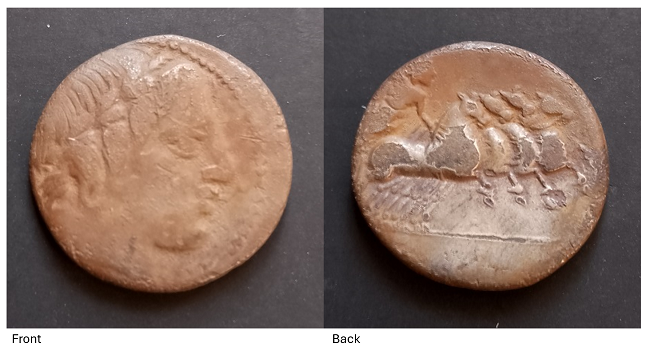
4. A denarius of the Roman Republic, dating to 90 BCE.
The front has the head of the god Apollo, facing right and wearing a laurel wreath.
The back shows the goddess Minerva riding in a four-horse chariot, heading right
The inscriptions on the coin have been worn away but we know that this design would usually read "PANSA" on the front, behind the head of Apollo, and "C VIBIVS CF" on the back, below the chariot. This shows that the coin was made under the authority of a mint official called C Vibius Cf Pansa.
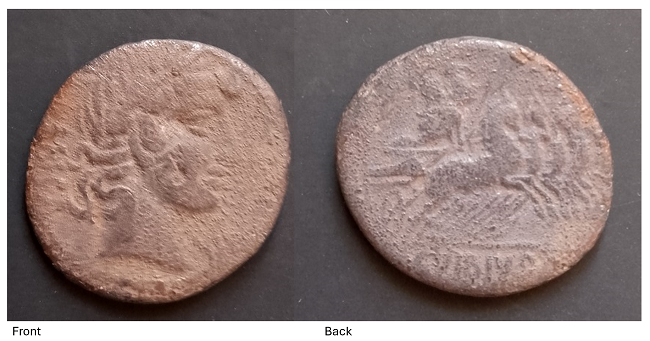
5. This is a second example of the coin of 90 BCE, struck for mint official C Vibius Cf Pansa.
It has the head of Apollo on the front, and Minerva in a four-horse chariot on the back.
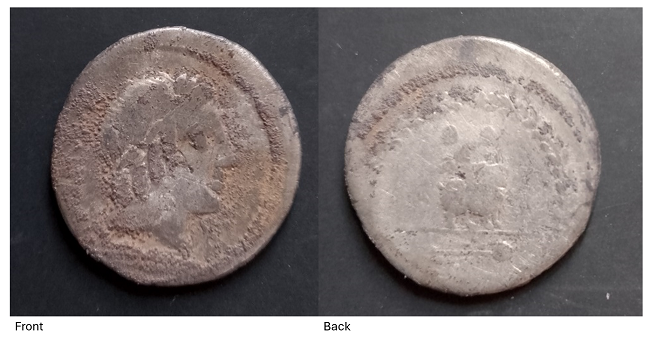
6. A worn denarius of the Roman Republic, dating to 85 BCE.
The front has the head of the god Apollo, facing right and wearing a laurel wreath. There is a thunderbolt symbol below the head.
The back shows the god Cupid on a goat, heading right. There are two hats above him, symbolising freedom, and a ritual sceptre below him.
The inscriptions on the coin have been worn away but we know that this design would usually read "MN FONTEI CF" on the front, behind the head of Apollo. This shows that the coin was made under the authority of a mint official called Mn Fonteius.
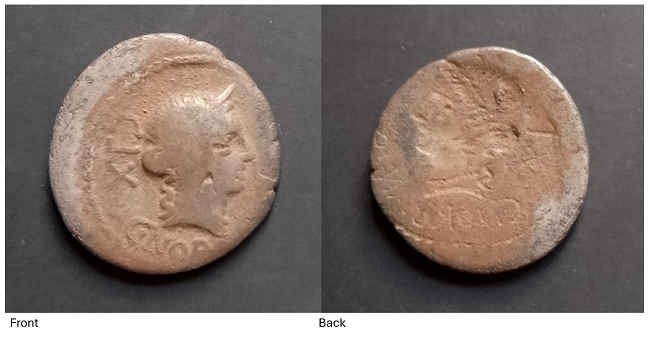
7. A denarius of the Roman Republic, dating to 83 BCE.
The front has the head of the goddess Venus, facing right and wearing a diadem head-dress. Behind the head is the inscription "CLX", which is 160 in Roman numerals. This is a control mark, used to identify different batches of coins. Below the head is the inscription "C NORBANVS", but with the last five letters missing. This shows that the coin was made under the authority of a mint official called C Norbanus.
The back of this design would usually show a row of ritual symbols - the prow of a ship, a bundle of sticks with an axe, a staff with snakes, and an ear of corn. However, when this coin was made there was a mistake in production and the back actually has a reversed image of the front design, instead of the intended back design.
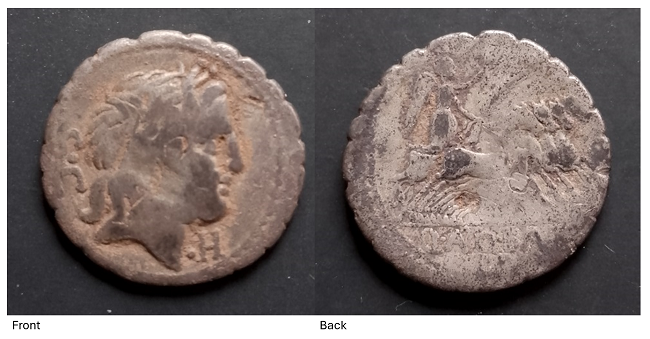
8. A denarius of the Roman Republic, dating to 83 – 82 BCE. This type of denarius has a serrated edge.
The front has the head of the god Jupiter, facing right and wearing a laurel wreath. Behind the head is the inscription "SC", and below is ".H". This latter is a control mark, used to identify different batches of coins.
The back shows the personification of Victory, riding in a four-horse chariot, heading to the right. She is holding the reins and a palm branch in her left hand, and a wreath in her right hand. Below the picture is the inscription "Q·ANTO·BALB / PR", with some of the letters worn away. This shows that the coin was made under the authority of a mint official called Q. Antonius Balbus.
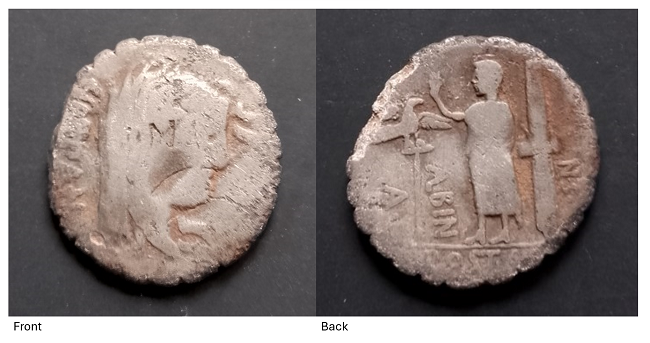
9. A denarius of the Roman Republic, dating to around 81 BCE. This is another type with the serrated edge.
The front has the head of Hispania, the personification of Spain, facing right and wearing a head veil. Behind the head is the inscription "HISPAN".
The back shows a human figure, wearing a toga, facing left, with its right hand raised. There is an eagle in front (in the form of the standard carried by the legions of the Roman army), and a bundle of sticks with an axe behind. The inscription on this side is spread around - it starts to the left of the image, then goes to the right, and finishes below. It reads "A. ABIN SN POST. A. F." This shows that the coin was made under the authority of a mint official called Aulus Postumius Albinus.
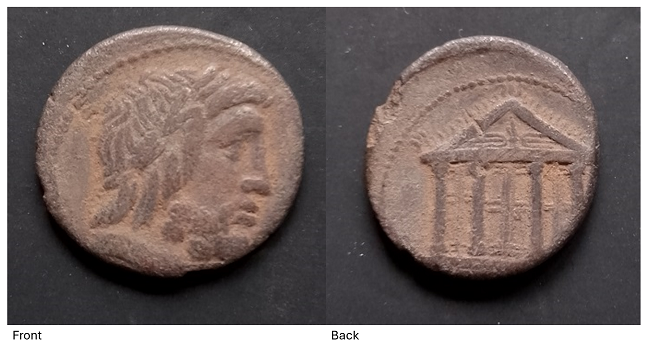
10. A denarius of the Roman Republic, dating to 78 BCE.
The front has the head of the god Jupiter, facing right, and wearing a laurel wreath.
The back shows the front of the temple of Jupiter Capitolinus (on the Capitoline Hill in Rome). The three large doors of the temple are closed, and there is a thunderbolt in the triangular pediment above the doors. We know from other examples that there would normally be an inscription below the design, but the coin has been made a bit wonky, and the part with the inscription has fallen off the edge! It should read "M.VOLTEI.M.F." This shows that the coin was made under the authority of a mint official called M. Volteius M.f.
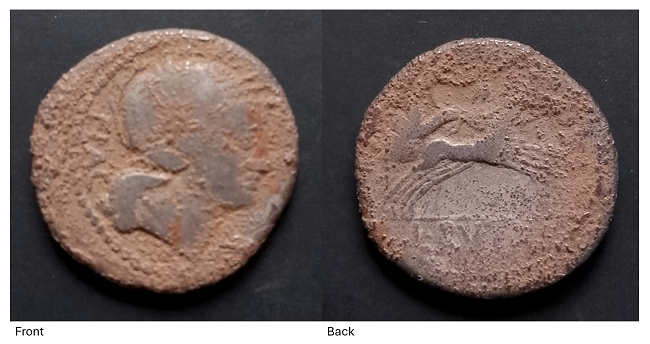
11. A denarius of the Roman Republic, dating to 77 BCE.
The front has the head of the personification of Rome, wearing a helmet and facing right. Behind the head is an inscription reading "FLAC".
The back shows the personification of Victory, riding in a two-horse chariot, heading right. She is holding the reins in her left hand and a wreath in her right. Beneath the design is the inscription "L.RVTILI", with the last few letters worn away. This shows that the coin was made under the authority of a mint official called L. Rutillius Flaccus.
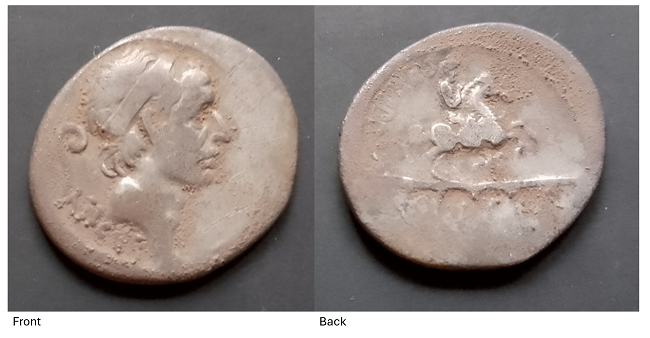
12. A denarius of the Roman Republic, dating to 77 BCE.
The front has the head of the legendary fourth king of Rome, Ancus Marcius (ruled c.640-616 BCE). He is wearing a diadem head-dress and facing right. Behind him is a curved ritual staff known as a lituus. Beneath the head is the inscription "ANCVS"
The back shows a section of an aqueduct with the inscription "AQVA MAR" within the arches. There is a statue of a man on a horse on top of the aqueduct, with a flower growing beneath it. Behind the image is an inscription reading "PHILIPPVS", although most of the letters are worn away. This shows that the coin was made under the authority of a mint official called L Marcius Philippus. Philippus claimed Ancus Marcius as his ancestor.
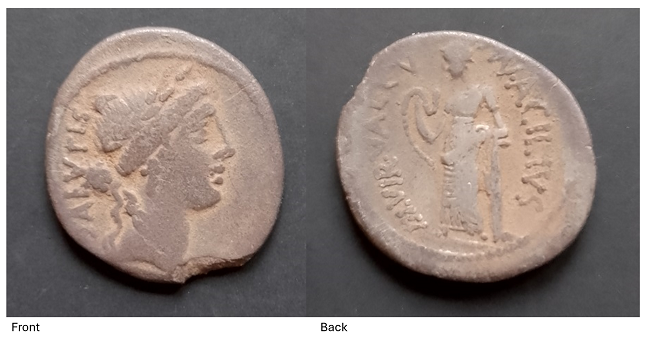
13. A denarius of the Roman Republic, dating to 49 BCE.
The front has the head of the goddess Salus (goddess of safety and security) facing right and wearing a laurel wreath. She is identified with the inscription "SALVTIS" behind the head.
The back shows the goddess Valetudo (goddess of health and hygiene) standing, facing left, resting her left arm on a pillar and holding a snake in her right hand. She is identified with an inscription on the left reading "III.VIR.VALETV". On the right is another inscription which reads "MN.ACILIVS". This shows that the coin was made under the authority of a mint official called Mn Acilius.
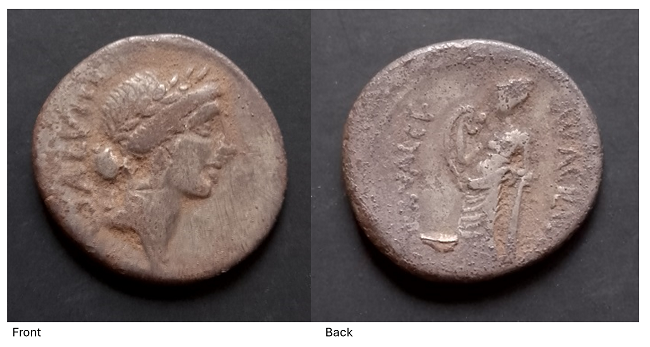
14. This is a second example of the coin of 49 BCE, struck for mint official Mn Acilius.
It has the head of Salus on the front, and Valetudo holding a snake on the back.
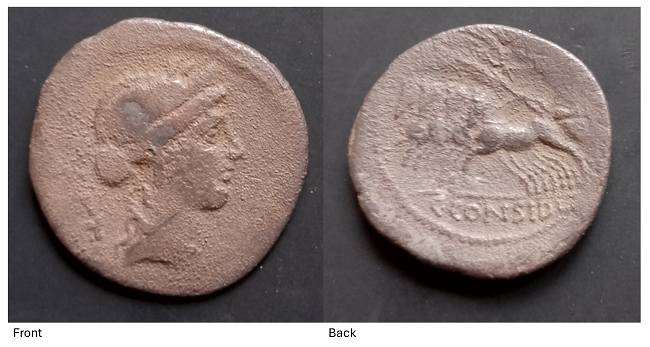
15. A denarius of the Roman Republic, dating to 46 BCE.
The front has the head of the goddess Venus facing right and wearing both a laurel wreath and a diadem head-dress. The inscription "PAETI" is behind the head.
The back shows the personification of Victory riding in a four-horse chariot, heading left. She is holding a large palm branch over the horses, and has a wreath raised up in her other hand. Beneath is the inscrption "C. CONSIDI". This shows that the coin was made under the authority of a mint official called C Considius Paetus.
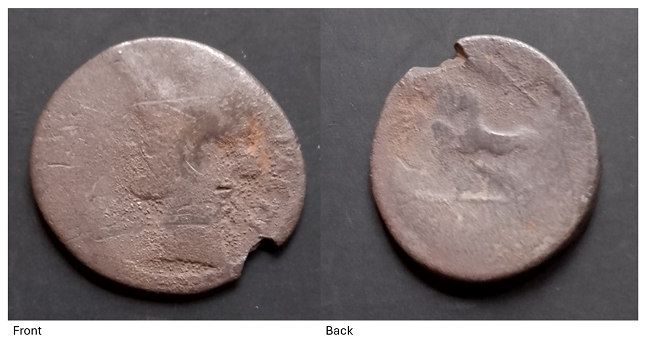
16. This is a very worn example of the coin of 46 BCE, struck for mint official C Considius Paetus.
The designs and inscriptions are almost worn away, but would have shown the head of Venus on the front and Victory in a four-horse chariot on the back.
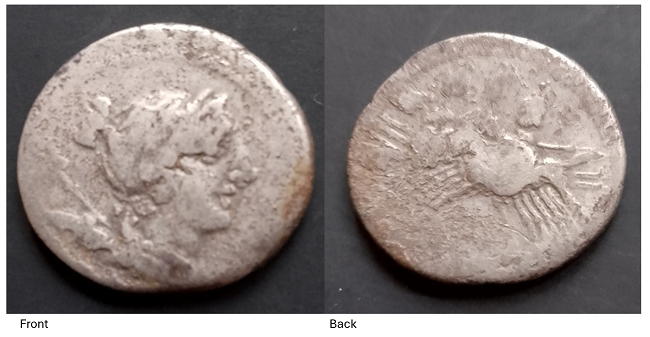
17. This is a third example of the coin of C Considius Paetus from 46 BCE. The images of Venus and Victory are clearer in this example, as are all the legs of the four horses drawing Victory’s chariot!
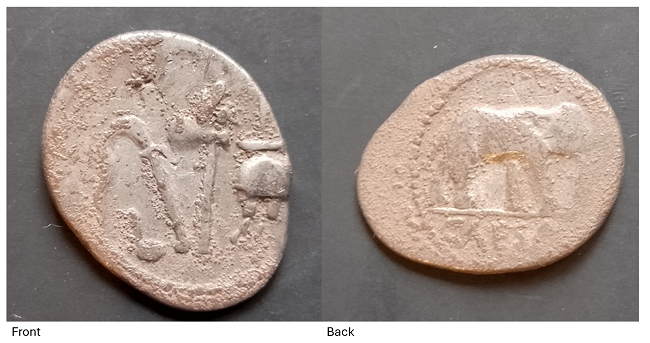
18. A worn denarius of the Roman Republic, dating to 49 BCE.
The front has four items which represent the Roman office of Pontifex, or High Priest. These are a horn-shaped vessel to hold milk or wine, a tool for sprinkling sacred liquids, a ritual axe, and a priest's cap.
The back shows an elephant, walking right, and trampling on a serpent. The inscription "CAESAR" is below the elephant. The coin was made at the start of the civil war which ended the Roman Republic and replaced it with an Empire. It was issued by Julius Caesar, without the permission of the Roman Senate, to proclaim his own might. Caesar used the elephant as a symbol of his family because one explanation for the name ‘caesar’ was that an ancestor killed an elephant in the Punic Wars and took the name from the Punic word for the beast: ‘caesai’.
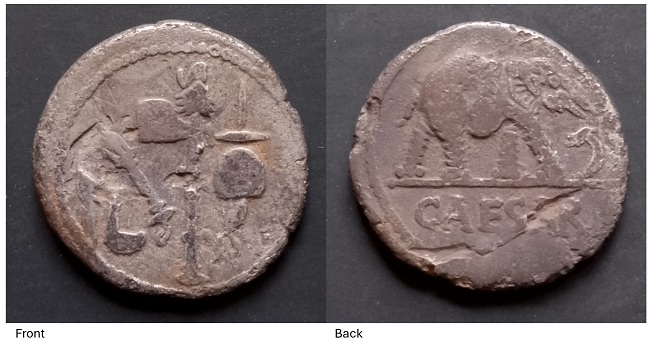
19. This is a second example of the coin of Julius Caesar from 49 BCE. The priestly implements and the elephant are clearer on this coin.
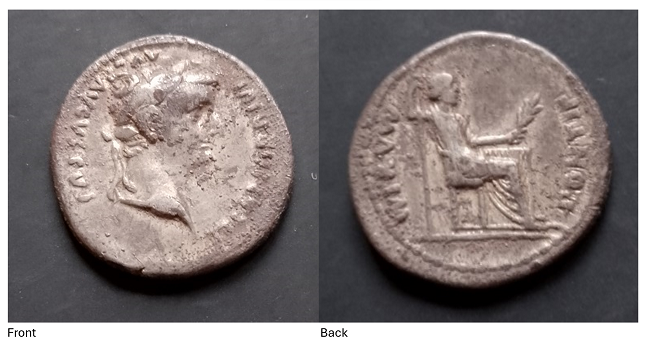
20. A denarius of Emperor Tiberius (reigned 14 - 37 CE).
The front has the head of the emperor, facing right, wearing a laurel wreath. Around the edge it reads "TI CAESAR DIVI AVG F AVGUSTVS", which can be translated as Caesar Augustus Tiberius, son of the Divine Augustus. This refers to his father, Emperor Augustus, who was declared a god after his death.
The back shows a woman, probably Tiberius' mother Livia, dressed as Pax, the personification of peace. She is sitting on a chair, facing right, holding a branch in her left hand, and a tall sceptre in her right. The inscription around the edge reads "PONTIF MAXIM", an abbreviation of the title Pontifex Maximus, or High Priest.
Coins of this type are sometimes called 'tribute pennies'. This is a reference to the incident in the bible where Jesus comments that when asked to pay tribute to Rome, the people should 'render unto Caesar that which is Caesar's'. Tiberius was Caesar at the time when Christ was alive, so it is likely that the tribute coins being discussed were denarii like this.
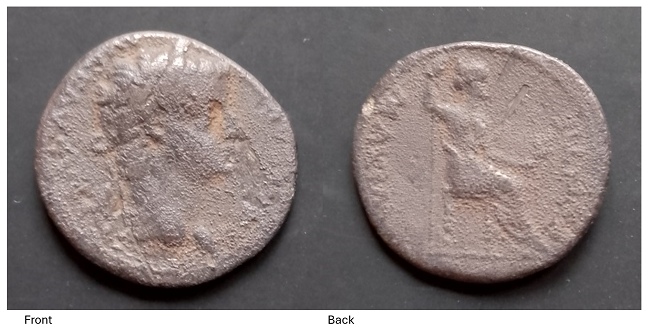
21. A second example of the denarius of Emperor Tiberius, with Livia as Pax on the reverse.
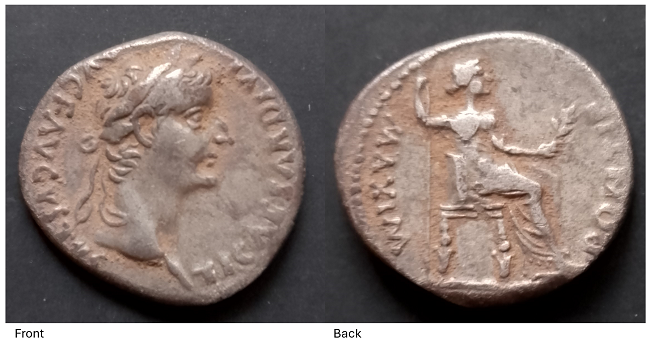
22. A third example of the Tiberius denarius. The portrait of Tiberius is especially crisp and recognisable on this coin!
FIND OUT MORE
The hoard is on display in the museum until Saturday 28 June, as part of the "Money Talks; Stories from the Coins" exhibition.
You can find out more about the coinage of the Roman Republic in this useful guide from the British Museum (now archived online by the National Archives): Online Research Catalogue: Roman Republican Coinage
Anja Thompson-Rohde, Collections and Interpretation Officer
Uploaded 7 May 2025
